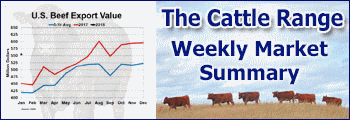LIVESTOCK & POULTRY:
For 2025, total red meat and poultry production is lowered. Pork production is lowered on reduced slaughter and weights. The current outlook for hog slaughter in 2025 reflects the information provided in the March 27 Quarterly Hogs and Pigs report that showed lower pig crops than previously reported for 2024 and indications of lower farrowings through much of 2025. Beef production is raised as heavier dressed weights and higher cow and bull slaughter are partially offset by lower steer and heifer slaughter. Broiler production is raised on improved returns during the second half of the year. Turkey production is lowered on recent hatchery and production data. Egg production is lowered on recent layer inventory and production data.
Beef exports are lowered for 2025 based on recent trade data, as well as newly imposed tariffs and non-tariff barriers faced by U.S. beef exports to China. Beef imports are lowered based on higher tariff rates for foreign suppliers for the remainder of the year.
Pork exports are lowered from the previous month due to the latest trade data, increased tariff rates for U.S. pork shipments to China, and price competition from other major exporting countries. Broiler exports are lowered on less competitive U.S. prices during the second half of the year. Turkey exports are lowered on recent trade data and reduced domestic production. Egg imports are raised on recent trade data.
Cattle prices are raised on reported data through the first quarter and expected robust demand for the remainder of the year. Hog prices are lowered, with slightly higher reported first-quarter prices more than offset by weaker export demand for the remainder of the year. Broiler prices are raised on recent reported data through the first quarter of the year and continued strength in domestic demand. Turkey prices are also raised on reported prices through the first quarter of the year and the lower expected supplies for the year. Eggs are lowered on recent prices and the expectation that the layer flock will recover over the remainder of the year.
CORN:
This month’s 2024/25 U.S. corn outlook is for greater exports, reduced feed and residual use, and smaller ending stocks. Feed and residual use is cut 25 million bushels to 5.8 billion based on disappearance during the December-February quarter as indicated in the March 31 Grain Stocks report. Exports are raised 100 million bushels reflecting the pace of sales and shipments to date and relatively competitive U.S. prices. With no other use changes, ending stocks are down 75 million bushels from last month to 1.5 billion. The season-average corn price received by producers is unchanged at $4.35 per bushel.
Global coarse grain production for 2024/25 is forecast 0.4 million tons lower to 1.495 billion. This month’s foreign coarse grain outlook is for reduced production, virtually unchanged trade, and larger ending stocks relative to last month. Foreign corn production is raised, with increases for the EU, Tanzania, and Honduras partially offset by declines for Moldova, Cambodia, and Kenya. EU corn is higher reflecting larger crops for Poland, Croatia, France, and Germany that are partially offset by reductions for Romania and Bulgaria.
Major global trade changes for 2024/25 include higher projected corn exports for the United States and a reduction for Pakistan. Corn imports are raised for the EU, Mexico, Turkey, and Peru but lowered for Vietnam. Foreign corn ending stocks are higher relative to last month, reflecting increases for South Korea and Pakistan. Global corn ending stocks, at 287.7 million tons, are down 1.3 million.
WHEAT:
This month’s supply and demand outlook for 2024/25 U.S. wheat is for larger supplies, slightly smaller domestic use, reduced exports, and increased ending stocks. Supplies are raised on higher projected imports, up 10 million bushels to 150 million, with increases for Hard Red Spring (HRS), Durum, White, and Hard Red Winter (HRW). At this level, imports would be the largest since 2017/18. Domestic consumption is forecast 2 million bushels lower on reduced seed use, based primarily on the March NASS
Prospective Plantings report. Feed and residual use is unchanged at 120 million bushels, but there are offsetting by-class revisions based on the March 31 NASS Grain Stocks report. Exports are lowered 15 million bushels to 820 million with reductions to HRS and HRW. Projected 2024/25 ending stocks are raised 27 million bushels to 846 million, 22 percent above the previous year.
The season average farm price is unchanged at $5.50 per bushel.
The 2024/25 global wheat outlook this month is for smaller supplies, consumption, and exports and larger ending stocks.
View Complete Report
Articles on The Cattle Range are published because of interesting content but don't necessarily reflect the views of The Cattle Range.














